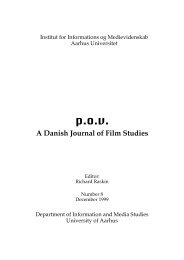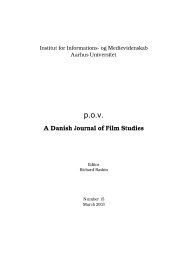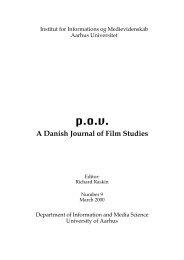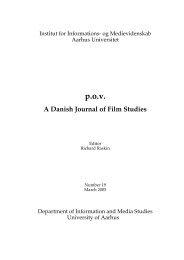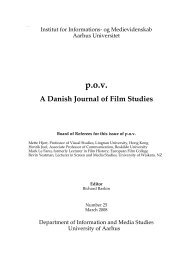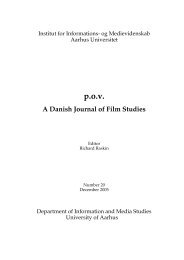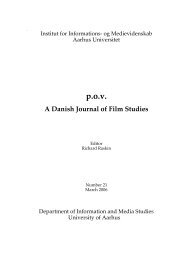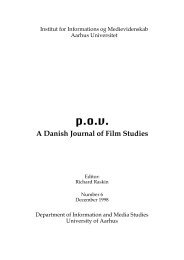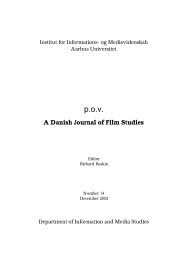The Face of Time - POV - Aarhus Universitet
The Face of Time - POV - Aarhus Universitet
The Face of Time - POV - Aarhus Universitet
You also want an ePaper? Increase the reach of your titles
YUMPU automatically turns print PDFs into web optimized ePapers that Google loves.
92 p.o.v. number 13 March 2002<br />
more precisely: the form <strong>of</strong> a movement from one question to<br />
another. <strong>The</strong> film has a special kind <strong>of</strong> temporality that gradually<br />
moves one from seeing to feeling. Or, to put it in another way, the<br />
film moves from a dimension <strong>of</strong> factual knowledge and understanding<br />
to an ethical dimension – in the special sense that the<br />
philosopher Emmanuel Levinas has given to the term.<br />
<strong>The</strong> first question<br />
As the film begins, three old women are seen standing in a row<br />
outside a house. <strong>The</strong>y all look intensely to the left. As the women<br />
keep on staring to the left, the camera slowly starts a panning<br />
movement to the right. Let us stop here for a moment.<br />
<strong>The</strong> first image contains a very common cinematic figure: the<br />
gaze <strong>of</strong> a character (or in this case, the gaze <strong>of</strong> three characters)<br />
functions as a cue <strong>of</strong> an <strong>of</strong>f-screen space. This cue might be<br />
described as a kind <strong>of</strong> question: "What do the women see?" <strong>The</strong><br />
"answer" to that question would be a camera movement or a cut that<br />
would show the space they are looking at. At this point the image is<br />
a "question" only in a kind <strong>of</strong> casual "let's-wait-and-see" manner.<br />
<strong>The</strong>re is perhaps mild curiosity about "what happens next" and<br />
about who these women are and what this film is about.<br />
However, instead <strong>of</strong> moving to the left and showing what the<br />
women see, the camera starts panning in the opposite direction. As<br />
the camera begins its movement it becomes evident that no<br />
immediate answer to the expectation created by the characters' look<br />
will be given. At this moment, I would like to argue, a true<br />
"question" emerges.<br />
What is the difference between these two "questions"? It is not<br />
that <strong>of</strong> content. What is being asked is the same thing: "What are



